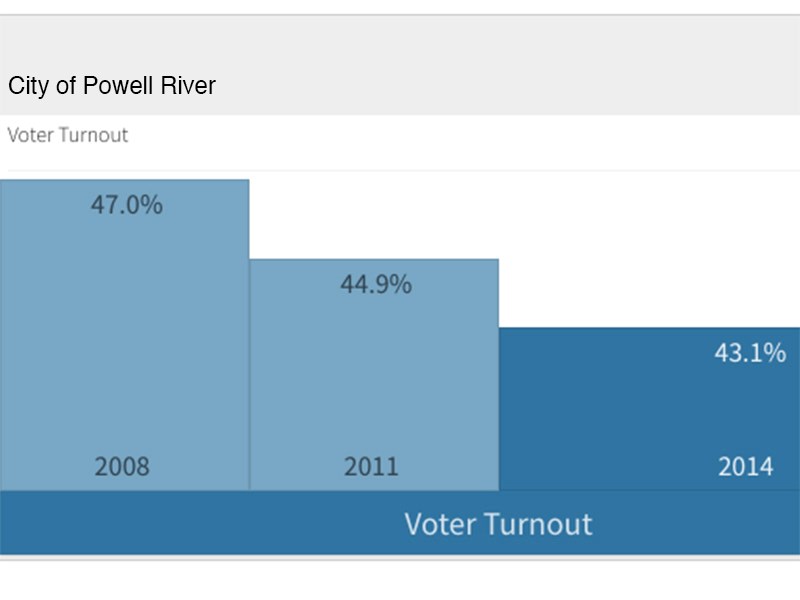How many people go to the polls and a block of more than 4,000 votes up for the taking are two factors that will determine the outcome of City of Powell River’s civic election on Saturday, October 20.
The biggest voting block who will decide the election is not the youth vote, retirees, male, female, labour workers, or any other demographic in Powell River. The largest number of voters is the people who do not vote.
Turnout at the first advance poll on October 11 was historically high, according to City of Powell River chief election officer and city clerk Chris Jackson. The final advance poll takes place from 8 am to 8 pm on Wednesday, October 17, in the Poplar Room at Powell River Recreation Complex.
Powell River is no different than any other jurisdiction in North America where people seem disinclined to go to polls. According to statistics from the non-profit society CivicInfo BC,since 2008 voter turnout for the civic election has been in steep decline. In 2008, 47 per cent out of an eligible 9,671 Powell River voters cast a ballot.
In 2011, it was 44.9 per cent out of 9,950 and in 2014 there were about 10,100 eligible electors, and turnout dropped nearly two more percentage points.
A contested campaign for mayor and two councillors choosing not to seek re-election could stem the turnout tide.
With the departures of Russell Brewer and Karen Skadsheim, at least two new councillors will be elected to fill their seats for the next four-year term. Candidates vying for seats are after more than 4,000 votes that are up for grabs.
After three terms, Brewer made the decision not to seek a fourth and, instead, is running for election to Powell River Board of School Trustees.
In 2011, with 2,487 votes, Brewer received the most votes for a city councillor, appearing on 57 per cent of the total 4,357 ballots cast.
After serving one term on council, Skadsheim has also decided not to run again. In the last election, her name was chosen on 1,999 (45.9 per cent) of the ballots.
Who those 4,000-plus votes go to, if anyone, depending on voter turnout, will go a long way toward determining the makeup of the next council.
While voter turnout declined over the last three elections, the estimated number of eligible electors increased a marginal one per cent, or 439 votes, from 9,671 in 2008 to 10,110 in 2014.
The estimated number of eligible voters in this year’s vote is 10,342.
The gender of both those running for council and those elected had been moving toward equality since 2008, when male candidates far outnumbered female candidates 17 to five. By 2014, eight men and six women were on the ballot.
But this year the split turned. Of the 16 names on the ballot, including mayor, five are women.
There was no change in the gender makeup of council in 2011 and 2014; three women and four men, including mayor, were elected or acclaimed in each of those years.
There are no rules to say a resident must vote for mayor and six councillors. An elector can mark their ballot for just mayor or not. Another might vote for mayor and all six council seats or just for a few councillors or any aggregate the elector decides on their private and confidential ballot.
In fact, there are no rules that say a person has to vote, at all.



